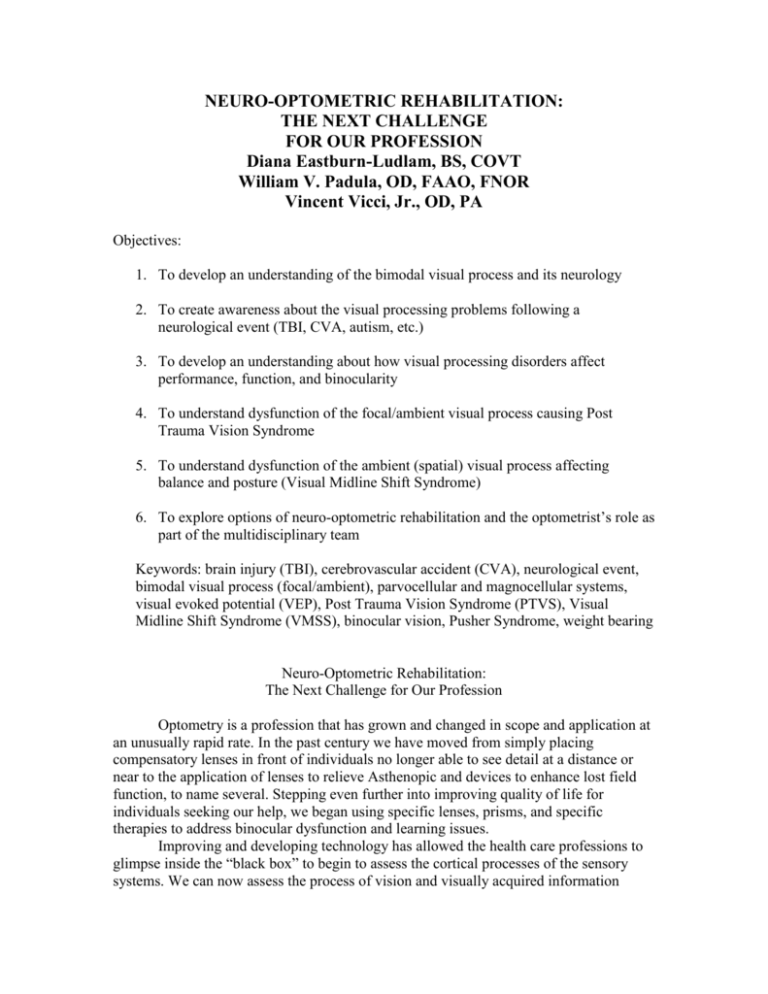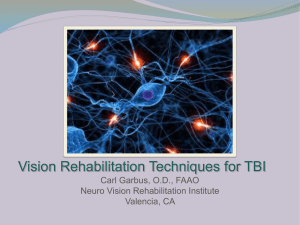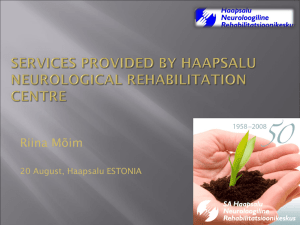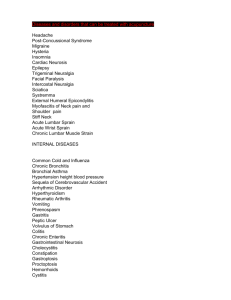outline6605
advertisement

NEURO-OPTOMETRIC REHABILITATION: THE NEXT CHALLENGE FOR OUR PROFESSION Diana Eastburn-Ludlam, BS, COVT William V. Padula, OD, FAAO, FNOR Vincent Vicci, Jr., OD, PA Objectives: 1. To develop an understanding of the bimodal visual process and its neurology 2. To create awareness about the visual processing problems following a neurological event (TBI, CVA, autism, etc.) 3. To develop an understanding about how visual processing disorders affect performance, function, and binocularity 4. To understand dysfunction of the focal/ambient visual process causing Post Trauma Vision Syndrome 5. To understand dysfunction of the ambient (spatial) visual process affecting balance and posture (Visual Midline Shift Syndrome) 6. To explore options of neuro-optometric rehabilitation and the optometrist’s role as part of the multidisciplinary team Keywords: brain injury (TBI), cerebrovascular accident (CVA), neurological event, bimodal visual process (focal/ambient), parvocellular and magnocellular systems, visual evoked potential (VEP), Post Trauma Vision Syndrome (PTVS), Visual Midline Shift Syndrome (VMSS), binocular vision, Pusher Syndrome, weight bearing Neuro-Optometric Rehabilitation: The Next Challenge for Our Profession Optometry is a profession that has grown and changed in scope and application at an unusually rapid rate. In the past century we have moved from simply placing compensatory lenses in front of individuals no longer able to see detail at a distance or near to the application of lenses to relieve Asthenopic and devices to enhance lost field function, to name several. Stepping even further into improving quality of life for individuals seeking our help, we began using specific lenses, prisms, and specific therapies to address binocular dysfunction and learning issues. Improving and developing technology has allowed the health care professions to glimpse inside the “black box” to begin to assess the cortical processes of the sensory systems. We can now assess the process of vision and visually acquired information electro physiologically enabling the optometric physician to evaluate quality, integration, and potential of the visual system on a neurophysiological basis. We are now able to monitor the cortical process as it changes by the application of lenses and prisms. This is of particular interest for individuals who have suffered head trauma or are living with progressive neurological disorders (multiple sclerosis, Parkinson’s, etc.) The human visual system is intricately designed and elegantly balanced and can be rendered functionally invalid often without detriment of correctable acuity. This can be the result of trauma (physical and/or emotional), progressive neurological disorder and/or a combination of these conditions. The challenge and new frontier for the profession is now to use the already defined characteristics that describe Post Trauma Vision Syndrome and apply the considerable body of knowledge existing in the use of prisms, lenses, and specific therapeutic procedures to alleviate the symptoms associated with this syndrome. To accomplish this goal demands a multidisciplinary effort. The ideal team consists of Physiatry, Neurology, Occupational Therapy, Physical Therapy, and NeuroOptometry, to name several. This introductory course is intended to begin to address the challenge and define some of the parameters. Some of you knew my late husband, William Ludlam. In knowing him you also knew his single mindedness and his devotion to this profession. He had an abiding dedication to pursuing scientific truth and applying that information to the alleviation of symptoms for individuals suffering symptoms of a visual system out of balance. He was a teacher, researcher, and scientist, but most importantly to him, a creative tireless clinician. He shared the vision of Dr. Padula, Dr. Vicci, Dr. Thomas, and others in a list too long to enumerate here that became the Neuro-Optometric Rehabilitation Association. It is my honor to introduce this two-hour focus course and to present Doctors Padula and Vicci. NEURO-OPTOMETRIC REHABILITATION MEETING THE VISUAL NEEDS OF NEUROLOGICALLY CHALLENGED PERSONS WILLIAM V. PADULA, OD, FAAO, FNORA Within the United States, there are over forty million persons with a neurological dysfunction. These include persons with traumatic brain injury (TBI), cerebrovascular accidents (CVA), multiple sclerosis (MS), cerebral palsy (CP), autism, Friedrick’s Ataxia, and Parkinson’s disease, to name several. The prevalence for neurological disorders is increasing due to: 1) Advances in medical science enabling more children to survive premature births and childhood diseases; 2) More persons surviving TBI due to faster and more advanced life support; 3) An increase in the aging population yielding CVA, Parkinson’s disease, etc.; 4) And, an increase in autism and pervasive developmental disorders. Those who have neurological dysfunction have a high prevalence of vision difficulties. These may include vision impairment such as hemianopsia and loss of acuity, however, the majority will have binocular vision problems, and visual spatial problems affecting posture, balance, and orientation. Over the past twenty years a new field has emerged in optometry known as NeuroOptometric Rehabilitation. This has occurred because those who are neurologically challenged often do not have the same needs of persons who are served through low vision or functional (binocular) vision services. Accompanying vision impairments and binocular problems are conditions of motor dysfunction (nerve paresis) sensory imbalances, and cognitive disorganization. There is also growing scientific evidence that the visual problems caused following a neurological dysfunction or event are due to cortical and sub cortical processing disorders. Two primary visual processing systems have been identified called the focal and the ambient visual process (Trevarthen 1973, Liebowitz and Post 1982). The focal process is primarily an occipital cortex system and is detail in orientation. The parvocellular system sub-serves the focal process and it receives as well as provides information from/to higher cognitive perceptual processes. The ambient visual process is a spatial component of vision which includes but is not limited to the mango-cellular system. Neurologically, the ambient process is organized in midbrain by matching information between kinesthetic, proprioceptive and vestibular processes for the purpose of establishing a spatial context and reference base from the sensory-motor systems. Once accomplished, this information is provided by “feed-forward” to the occipital cortex and 99% of the cortex. This spatial information is relayed from superior colliculus to binocular coordination cells in order to spatially reference the process of binocular integration. In addition, through the ambient process spatial reference is established for orientation of the focal process. It has been determined that interference with the ambient visual process will affect the function of the focal system. This can occur from a neurological event such as TBI, CVA, etc. Even from a whiplash, dysfunction of the ambient process can occur yielding an imbalance and disassociation between relationship of the focal and ambient processes. The disassociation leads to a type of focal binding that has been called Post Trauma Vision Syndrome (PTVS) (Padula, Argyris, Ray 1994). Research through use of visual evoked potentials with TBI subjects has documented improvement in the amplitude in P-100 cross pattern reversal tests by using base-in prism and bi-nasal occlusion. Additional research has found similar results (Sarno, et al. 2000). It has been found that PTVS is also associated with specific characteristics of binocular dysfunction and symptoms (Figure 1) and that these are a correlation of these characteristics to ambient vision dysfunction. Neuro-Optometric Rehabilitation is the science and art of diagnosing and treating dysfunction of the bi-modal visual process following a neurological event affecting binocularity, balance and posture through use of lenses. Doctors of optometry practicing this specialty often have rehabilitation hospital privileges and affiliations. This has led to optometrists being included as part of the interdisciplinary rehabilitation team and a close working relationship with physiatrists, neurologists, occupational, physical and speech therapists, psychologists, nurses, etc. The emerging field of Neuro Optometric Rehabilitation has developed to meet the visual needs of neurologically challenged persons. Further, Neuro Optometric Rehabilitation serves as the bridge between current visual-neurological research and state-of-the-art clinical treatment. Neuro Optometric Rehabilitation provides a unique framework for studies and research about related visual processing disorders caused by neurological events and the means to serve these afflicted individuals through noninvasive and often life-changing treatment approaches. TABLE I POST TRAUMA VISION SYNDROME Common Characteristics and Symptoms Characteristics Symptoms Exotropia of High Exophoria Possible Diplopia Accommodative Dysfunction Objects Appear to Move Convergence Insufficiency Poor Concentration and Attention Low Blink Rate Staring Behavior Spatial Disorientation Poor Visual Memory Poor Fixations and Pursuits Photophobia (Glare Sensitivity) Unstable Ambient Vision Asthenopic Symptoms Dizziness or “Lightheadedness” TABLE II VISUAL MIDLINE SHIFT SYNDROME Associated Characteristics and Symptoms Characteristics Symptoms Hemiplegia Floor May Appear Tilted Hemiparesis Walls and/or Floor May Appear to Move Flexion Extension Person Leans Away From Affect Side Side Neglect “Pusher” Syndrome I. Introduction A. Demographics B. Building a Model of Vision to Affect Rehabilitation II. Neuro-Anatomy A. Statistics B. Neurology 1. Central Fibers 2. Lateral geniculate 3. Peripheral Fibers 4. Midbrain a. Superior Colliculus 5. Spino-tectal Tract 6. Occipital Cortex III. Vision: The Process A. Focal Process 1. Occipital Cortex a. Identification b. Detail c. Concentration d. Attention B. Ambient Process 1. Spatial Orientation 2. Balance 3. Coordination 4. Movement 5. Anticipation of Change C. Relationship to Neurology 1. Axons from Lateral Geniculate to Midbrain 2. Sensory-Motor Feedback Loop 3. Magnocellular Fibers 4. Parvocellular Fibers 5. Ambient Vision Neurology D. New Concept 1. Perception IV. Post Trauma Vision Syndrome (PTVS) A. Symptoms 1. Movement of Print when Reading 2. Headaches 3. Eye Strain 4. Diplopia 5. Photophobia 6. Hallucinations B. Characteristics 1. Exophoria 2. Exotropia 3. Convergence Insufficiency 4. Accommodative Dysfunction 5. Myopia C. Research 1. Dysfunction of Pursuit Tracking 2. Focusing 3. Convergence 4. Accommodation 5. Refraction V. Visual Midline Shift Syndrome A. Visual Midline Test B. Compromise of the Ambient Visual Process C. Relationship to Posture and Balance D. Symptoms 1. Seeing Movement in Peripheral Vision 2. Seeing Floor Tilted or Distorted E. Characteristics 1. Leaning to Side 2. Hemiparesis or Hemiplegia 3. Paradoxal Visual Midline Shift F. Treatment 1. Use of Yoked Prisms/Affect on Wheelchair Positioning VI. Therapeutic Intervention for Persons with Post Trauma Vision Syndrome and Visual Midline Shift Syndrome VII. Conclusion






